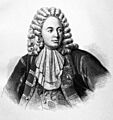Patrick Gordon facts for kids
Quick facts for kids
Patrick Gordon
|
|
|---|---|
 |
|
| Born | April 10, 1635 [O.S. March 31, 1635] Auchleuchries, Aberdeenshire, Scotland |
| Died | 29 November 1699 (aged 64) Moscow, Russia |
| Buried |
Vvedenskoye Cemetery
|
| Allegiance |
|
| Years of service | 1655-1699 |
| Rank | General |
| Battles/wars |
|
Patrick Gordon (born March 31, 1635 – died November 29, 1699) was a Scottish soldier who became a very important general and rear admiral in Russia. He came from a family in Aberdeenshire, Scotland.
Patrick Gordon served in the armies of Sweden, Poland, and Russia. He started as a regular soldier and worked his way up to become a full general. He was a close friend and trusted advisor to Peter the Great, who was the Tsar (ruler) of Russia.
Contents
Early Life and Adventures
Patrick Gordon was born in Auchleuchries, Aberdeenshire, Scotland. He grew up as a Roman Catholic. At that time, Catholics in Scotland faced difficulties because the country had become officially Protestant.
When he was fifteen, Patrick went to a Jesuit school in Poland. However, he found the school's strict rules hard to follow. He decided to leave and travel. In 1655, he joined the Swedish army in Hamburg.
Serving Different Countries
For the next five years, Patrick Gordon fought for both Poland and Sweden. He was even captured by both sides during these wars! In 1660, he was injured at the Battle of Chudnov.
After hearing that the king was back in power in England, Gordon left the Polish army. He tried to find military work in Scotland or England, but he couldn't. So, in 1661, he joined the Russian army under Tsar Aleksei I.
Life in Russia
Patrick Gordon found the Russian army challenging at first. He complained about corruption, which means people were dishonest and took bribes. Despite this, he proved himself in battles against the Turks and Tatars in southern Russia.
Because of his good service, he was promoted to major-general in 1678. He was put in charge of the army in Kiev in 1679, and then became a lieutenant-general in 1683. Many other Scottish soldiers also served the Tsar, looking for opportunities to make a name for themselves.
Helping Peter the Great
In 1686, Gordon visited England and Scotland. He returned to Russia and took part in important military trips against the Tatars in the Crimea in 1687 and 1689. After these trips, he was made a full general.
In 1689, there was a struggle for power in Moscow. Patrick Gordon and his soldiers played a key role in helping Peter the Great win against his half-sister, Sophia Alekseyevna, who was ruling Russia at the time. Because of this, Peter the Great trusted Gordon deeply for the rest of his life. The Tsar even left Gordon in charge of Moscow when he was away.
In 1696, Gordon designed a special "moveable rampart" (a type of movable wall for protection). This invention was very important in helping the Russians capture the city of Azov.
A Lasting Impact
One of Patrick Gordon's biggest achievements was getting permission from the Tsars to build the first permanent Roman Catholic church and school in Moscow. He was the main supporter of these places and led the Catholic community in Russia until he died.
The Tsar also relied on Gordon to help organize the Russian army. Gordon helped train the army using methods from Western Europe.
Patrick Gordon died in Moscow, Russia, on November 29, 1699. Tsar Peter the Great visited him often during his illness and was with him when he passed away. The Tsar even closed Gordon's eyes himself.
Gordon's Diary
Patrick Gordon kept a very detailed diary about his life and the times he lived in. He wrote it in English. This diary is still kept in a military archive in Moscow today. It gives us a unique look into his adventures and the history of Russia during that period. Parts of his diary have been published as books.
His daughter Catherine married a German-Russian colonel. Later, she married Alexander Gordon, who was also a general in the Russian army and wrote a book called The History of Peter the Great, Emperor of Russia.
Images for kids



